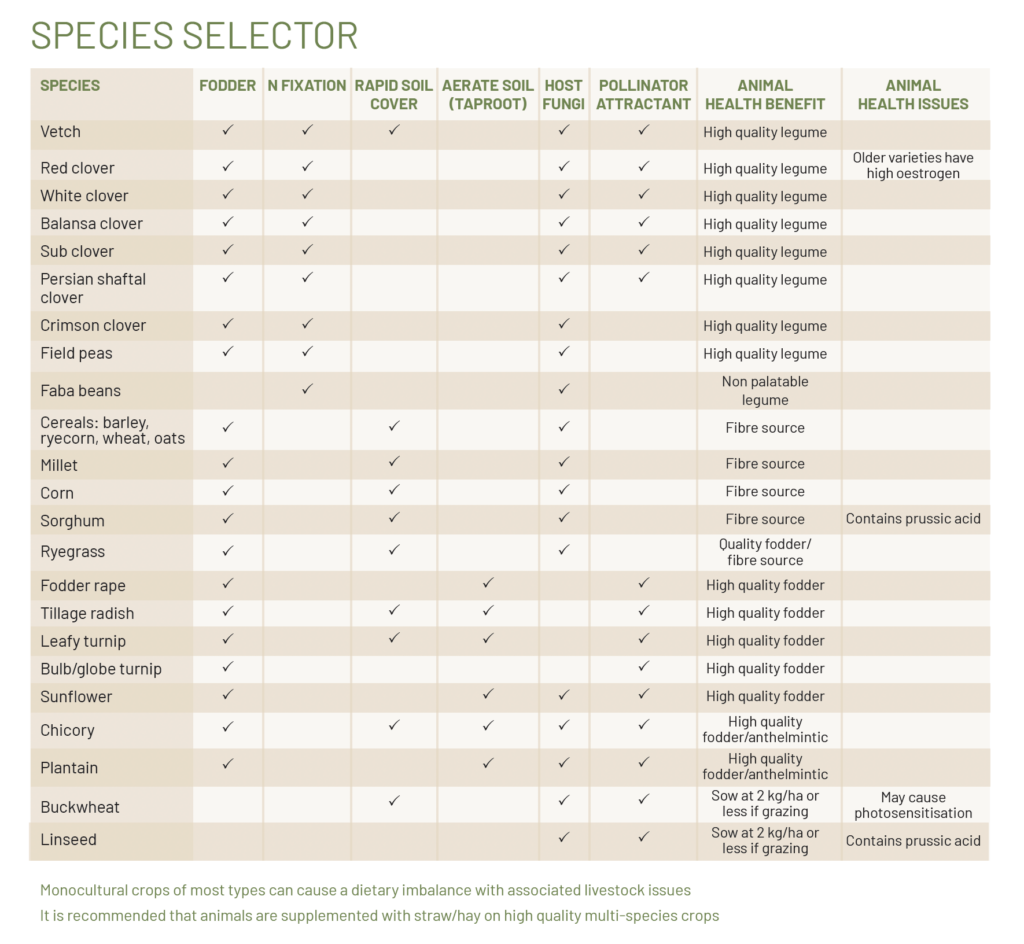Sowing for success by Jade Killoran
Summer & autumn multi-species pastures
What are multi-species pastures?
A multi-species fodder mix contains a diverse blend of 4-15 species across at least four plant families (legumes, grasses, brassicas and forbs) that are planted for fodder and soil health purposes.
What are the benefits?
Armouring the soil
Multi-species mixes containing annual plant species rapidly cover, or ‘armour’ the soil, which prevents wind, water and sun damage to the soil surface, helps reduce weed pressure and provides organic matter. If the mix contains summer active plants, extra groundcover also keeps topsoil shaded and cool, providing a stable environment for soil biology.
Filling feed gaps with a balanced diet
Feed gaps in livestock or mixed system farms can impact profit margins and reduce farm resilience. Multi-species mixes can be tailored specifically to produce feed when it is needed most. Summer multi-species are very effective at reducing the summer feed gap when European pasture species such as ryegrass shut down. In addition, the mixed diversity provides a balanced diet to livestock, in comparison to mono-culture or low diversity pasture blends. Deeper tap-rooted species commonly contained in multi-species mixes also improve aeration, infiltration and nutrient acquisition from the subsoil. As a result, fodder production and quality can improve, often improving animal production and health.
Improving soil health through increased diversity
The diversity of a multi-species mix improves fodder production, protects soil, improves ecosystem function and most importantly, supports a diverse and active soil biological population.
The living roots of plants provide a food source for soil biology, by transferring carbon exudates from photosynthesis into the soil surrounding the root system. A multi-species mix contains a diverse array of plant species, which provides a diversity of exudates to soil biology for the majority of the season.
Increases in soil biological activity are linked to increases in soil organic matter, soil organic carbon, soil aggregation, moisture retention and nutrient cycling. Studies have also shown that increased species diversity correlates with significantly reduced pest insect populations. Supporting soil biology allows farms to become more productive, profitable and sustainable.
Sowing a summer multi-species: Tips from current trials
Have a goal
A clear goal is essential when designing a multi-species program. Some questions to ask might be:
- Is the focus fodder production, or soil improvement, or both?
- Is one more important than the other?
- What soil improvements do you require?
- When is your feed gap, and how severe is it?
The seed mix will vary according to the goal. The best chance of success is to have a clear goal that you can communicate to your agronomist or seed company.
Prepare the paddock
Choosing an average paddock on the farm can give a realistic idea of how successful the mix will be. The temptation may be to sow the worst paddock on-farm, but it is important to bear in mind that how the mix performs in that paddock does not reflect its likely average performance on-farm.
Competition control and adequate moisture at sowing are the biggest determinants of success.
Reduce competition
Existing plants will almost certainly be an issue, especially if the paddock hasn’t been disturbed for several years. Weeds and strongly established perennials will need to be dealt with. Hard grazing and sowing ‘green’ is rarely successful on its own. Some level of cultivation or chemical is usually necessary at least for the first few sowings. Management of competition is key to success.
Sow according to moisture
Sow into moisture as early as possible, or wait for an opportune rainfall event. Moisture for establishment is crucial. After the plants are well established, they can survive dry periods if necessary. Fallowing paddocks beforehand could help to reserve moisture in low rainfall zones.
Sowing
Timing
Early spring sowing gives best dryland results – September/October, with soil moisture. If using summer active grasses such as millet and sorghum, check your soil temperature before sowing to make sure it is adequate. To sow millet, soil temps should be 14 °C and over, sorghum 16°C and over.
Post-October sowing is more opportunistic. If you are sowing dryland, be realistic about your soil moisture profile and predicted summer rainfall when judging the likelihood of successful establishment. Use a lower diversity, low-cost summer mix and have the seed on hand if that opportunistic rainfall event comes along.
Depth
Sowing deeper to find moisture is usually okay in summer, because the larger seeds tend to germinate and open up the ground for smaller seeds. Autumn sowing can be shallower to suit smaller seeds if needed.
Choose your summer species wisely
Start with an annual, or mainly annual mix. Fast-growing annual species are a lower cost, more aggressive choice for the first few sowings, as they cope with poorer conditions, and are faster to establish than perennials. This means they have a better chance of beating weeds, and are more resilient to insect attack. Annuals provide groundcover and fodder more rapidly and fit a short out of season sowing/growing window much more effectively than a perennial mix.
Keep the mix simple
A spring/summer mix, especially for the first few sowings, should be less diverse than an autumn multi-species mix due to the riskier sowing timing. A 6-way blend has enough diversity to be beneficial while being low cost. Avoid exotic seeds which can add cost without guarantee of success.
Some proven performers in Victoria are:
Sunflowers, tillage radish, fodder rape, millet, red/arrowleaf clover, buckwheat*.
This mix can be sown when soil temps reach about 14°C and is diverse enough (5 families) that at least one or two species should grow, but simple enough to be low cost. The mix should also provide a balanced diet for livestock and flowers for pollinators and other beneficial insects. Pre-made seed mixes are also available from most seed companies trading in Victoria. Bare seed is preferred rather than seed treated chemically with fungicides or insecticides, due to the impact these treatments may have on soil biology.
*Buckwheat should be sown at no more than 2 kg/ha in a mix if grazing is planned.
Consider using biologicals on the seed
A seed coat using a worm juice, fish/seaweed solution or compost extract often improves the germination and establishment of the seed.
Grazing
Once the multi-species passes the twist and pull test (indicating that the roots are firmly anchored into the soil), grazing can begin if feed is needed.
The nutritional value of the mix as a whole is usually best in the vegetative state, but a bit of fibre from the grass species becoming mature doesn’t hurt because the rest of the mix is usually high quality legumes and broadleaves.
If sown into moisture, or just prior to a really good rainfall event, spring/summer mixes should give at least one good grazing with maybe a pick at a second pre-autumn grazing. More if temperature/rainfall is good.
Autumn mixes usually have 2-3 grazings depending on the time of sowing and the spring use of the paddock.
Don’t be scared to terminate the mix during the summer if it is using too much moisture
In low rainfall environments, if stored soil moisture is required for autumn sowing, terminate the mix if needed and leave the residue on the paddock to provide cover. A multi-species that grows for as little as 6-8 weeks will still contribute to soil health and groundcover even if it hasn’t grown much biomass above ground.

Start small to manage risk
Starting off with 1-3 paddocks, or at most, no more than 10% of the farm, will help manage seasonal risk and keep management of the mixes to a feasible level.
Starting off slowly and comparing the multi-species to normal practice in terms of input cost, groundcover, fodder production (grazing days) and topsoil testing is easily achievable on smaller areas and will really help determine how beneficial the multi-species are for your farm business.
Happy sowing and growing!




